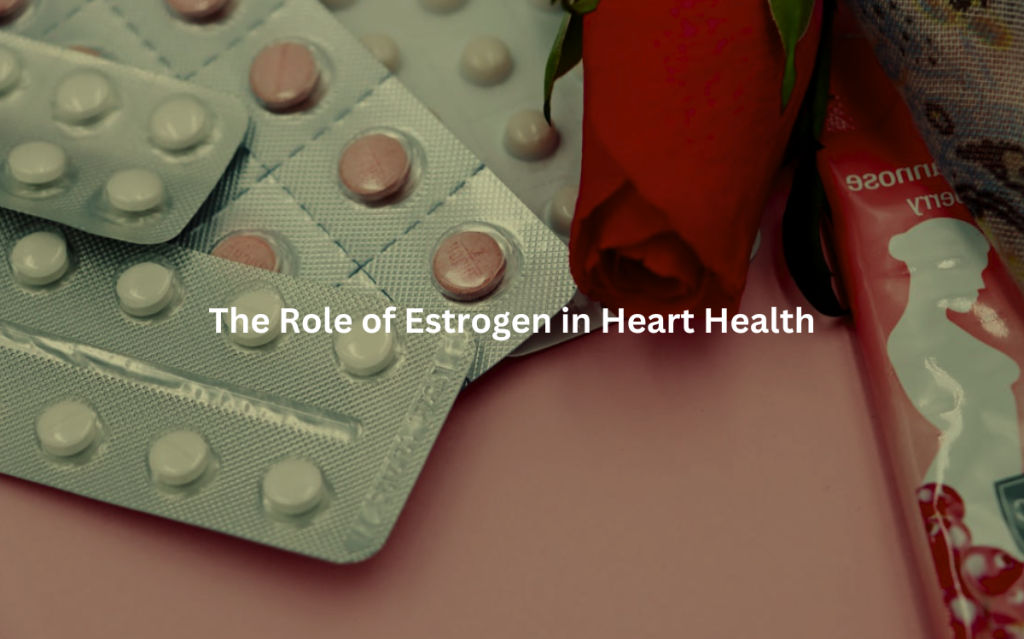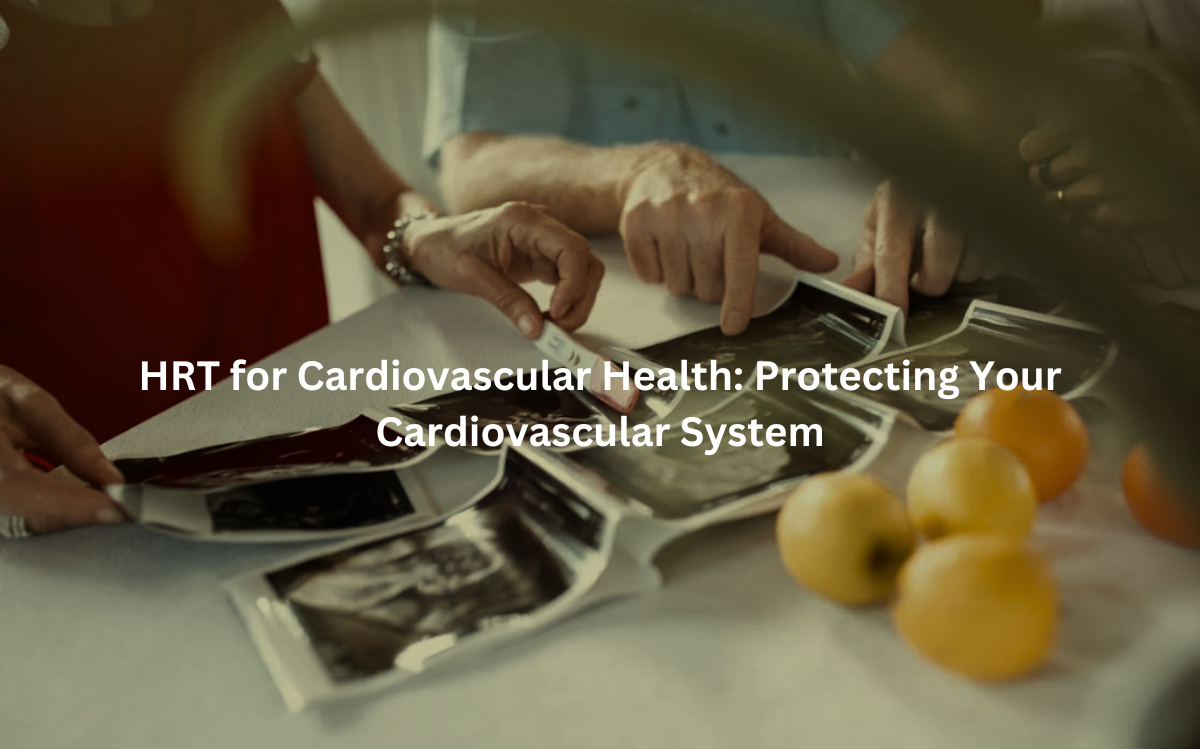Learn how HRT can improve cardiovascular health during menopause and its key benefits and risks.
Hormone replacement therapy (HRT) isn’t just about managing menopausal symptoms; it can also play a crucial role in protecting heart health. (1)
As estrogen levels decline with menopause, women face increased risks for cardiovascular diseases. This article explores how HRT can reduce those risks, the potential benefits for your heart, and the considerations to keep in mind when using HRT.
Key Takeaways
- HRT might improve cardiovascular health by reducing the risks of heart disease after menopause.
- Transdermal estrogen is considered safer for heart health compared to oral forms.
- Regular reviews of HRT are important to monitor effectiveness and minimize risks.
Hormone Replacement Therapy and Heart Health
Menopause often marks more than just the end of fertility—it also brings significant cardiovascular changes. As estrogen levels decline, so does its protective effect on the heart.
This can lead to an increased risk of heart disease. However, the good news is that hormone replacement therapy (HRT) may help reduce this risk.
Many women approach menopause with concerns about heart attacks, strokes, and high blood pressure. It’s true that heart disease risk rises during menopause, but studies suggest that HRT, when administered correctly, could prevent or slow down the development of heart problems.
However, not all HRT options are the same. For heart health, transdermal estrogen—applied through patches or gels—is typically considered the safest.
This is because transdermal estrogen bypasses the liver, reducing the risk of blood clots, which can be more of a concern with oral estrogen. The goal is to minimise risks while still benefiting from HRT’s heart-protective effects.
How HRT Protects Your Heart
Hormone Replacement Therapy (HRT) works by replacing the estrogen lost during menopause. This helps stabilize blood vessels and reduce the chances of plaque buildup in the arteries.
- Estrogen protects cholesterol levels, blood pressure, and the vascular system.
- Without estrogen, these systems become more vulnerable to damage, especially as women age.
Research shows that women who begin HRT within 10 years of their last period are at a lower risk of heart disease. This period is when the benefits of HRT are most pronounced.
For women who start later, the benefits become more complicated. In these cases, the risks might outweigh the rewards. Timing is crucial. (2)
While HRT can be an effective tool, it is not a cure-all. It should be part of a broader strategy, which includes:
- A healthy diet
- Regular exercise
- Frequent medical checkups
For example, a 50-year-old woman with heart disease may need a customized approach to HRT. This should be done under the supervision of a healthcare provider experienced in both heart health and hormone therapy.
Risks of HRT: Balancing Benefits with Caution
Despite the promising benefits, HRT isn’t without its risks. It’s a delicate balancing act. For some, HRT might increase the risk of developing blood clots or worsen existing cardiovascular problems. That’s why starting HRT post-menopause or for women with a history of heart disease requires extra care.
Oral HRT, in particular, carries a higher risk of blood clots and stroke. This is why women with high blood pressure, cholesterol, or those at risk for heart disease might want to opt for transdermal forms, as they tend to avoid the liver and reduce clotting risks.
Another concern with long-term HRT use is breast cancer. While the risk is small, it’s real, especially if combined with progestogen over several years.
Women who use HRT for more than five years might experience a slightly increased risk of breast cancer, particularly with combination therapy. The key is to have regular check-ups and ongoing consultations with your doctor to determine if continuing HRT is worth it.
The Role of Estrogen in Heart Health

Estrogen isn’t just a female sex hormone; it plays a critical role in cardiovascular function. It helps to regulate blood pressure, cholesterol, and the health of blood vessels.
In fact, before menopause, women tend to have lower cholesterol and better circulation than men, partly because of the protective effects of estrogen.
When estrogen levels drop during menopause, this protective effect fades, and women become more vulnerable to issues like high cholesterol and plaque buildup in the arteries.
The heart, as well as the bones, brain, and other organs, rely on estrogen to stay in top shape. That’s why estrogen replacement in the form of HRT is so important for postmenopausal women looking to protect their cardiovascular system.
Transdermal Estrogen: The Safer Choice for Heart Health
Transdermal estrogen has emerged as the safer alternative for women with cardiovascular risks. Unlike oral estrogen, which is processed by the liver and can increase clotting risks, transdermal estrogen is absorbed directly into the bloodstream, bypassing the liver.
This leads to a much lower risk of clotting and heart-related issues, which is a major concern for older women or those with existing health conditions.
Research supports this: Studies show that transdermal estrogen, when applied through patches or gels, does not significantly increase the risk of blood clots, strokes, or heart attacks.
That’s why it’s the preferred method for women who are post-menopausal and looking to protect their heart health while managing symptoms like hot flashes or night sweats.
While transdermal HRT is generally considered safer, it’s not risk-free. The best approach is to work closely with your healthcare provider to monitor how the body responds, making adjustments when necessary.
The Importance of Regular Monitoring
One of the most important things to remember about HRT, especially when it comes to heart health, is the need for ongoing monitoring.
Starting HRT might be beneficial, but it doesn’t end there. Regular checkups are crucial to ensure the treatment is working as expected and not causing any unforeseen complications.
Blood pressure, cholesterol levels, and other key cardiovascular markers should be checked frequently, especially in the first few months of HRT use.
If you’re feeling a new symptom, or if something doesn’t feel right, don’t hesitate to get checked. Regular screenings ensure that heart health stays on track while managing the potential side effects of HRT.
Managing HRT After a Heart Event
For women who’ve had heart issues like a heart attack or stroke, the decision to use HRT should be carefully made. The good news is that recent studies show that starting estrogen therapy after a heart attack doesn’t necessarily worsen outcomes.
However, transdermal estrogen is still the preferred method for these women to avoid the risks associated with oral estrogen.
Each case is different, and it’s important to have a conversation with your doctor about the benefits and risks. Sometimes, the symptoms of menopause might be severe enough to warrant the use of HRT even after a heart event, but this needs to be a very carefully weighed decision.
Conclusion
HRT offers a way to not only ease the discomforts of menopause but also protect cardiovascular health during a time when risks for heart disease are higher.
The decision to start HRT should be made with a healthcare provider, considering individual health risks and the timing of treatment.
Women under 60 or within 10 years of menopause tend to see the best results, especially with transdermal estrogen.
It’s important to stay informed, keep regular check-ups, and balance the benefits with the risks. And remember, HRT is just one part of the puzzle—lifestyle changes, like staying active, eating a balanced diet, and managing stress, are also critical to ensuring long-term heart health.
By understanding the heart-protective effects of HRT, women can make more informed decisions about their health and manage menopause with confidence.
Don’t let menopause hold you back—book your personalised consultation with Modern Menopause today and start your journey to feeling like yourself again.
FAQ
What is the role of HRT in reducing cardiovascular disease (CVD) risk in women?
HRT, especially when initiated early during menopause, may help reduce the risk of CVD by improving lipid profiles and vascular health.
Women aged 50–59 and within 10 years of menopause may experience a lower risk of heart disease, as estrogen supports blood vessel health and reduces bad cholesterol. However, for high-risk women, such as those with coronary artery disease, HRT may not be advisable due to increased CVD risk and possible adverse effects like stroke.
Does HRT affect the risk of VTE in women?
Yes, HRT can increase the risk of VTE, particularly with oral estrogen. Women with high risk of vascular disease, or those with a high BMI, may face a greater risk of VTE.
Transdermal HRT is preferred in these cases because it carries a lower risk of clotting. Women with certain health care conditions should consult a specialist before starting hormonal therapy.
How does age impact the benefits and risks of HRT for cardiovascular health?
Age is a key factor when considering HRT for cardiovascular health. In women aged 50-59, HRT can be beneficial for CVD prevention, improving heart health and reducing bad cholesterol. However, for women over 60, especially those with existing CVD or stroke, the risks may outweigh the benefits, as the therapy could increase the absolute risk of cardiovascular events. A personalized approach to decision making is essential.
Can younger women benefit from HRT for heart health?
Yes, younger women, particularly those within 10 years of menopause, can benefit from HRT in terms of heart health.
Studies suggest that when HRT is initiated early, it may help lower the risk of CVD by improving cholesterol levels and supporting vascular function. However, risk factors, such as body mass and family history, must be taken into account when determining the best approach.
How do HRT and the risk of cancer relate to cardiovascular health?
Long-term HRT may slightly increase the risk of cancer, including breast and ovarian cancer, especially with combined CEE plus MPA therapy.
This is a crucial consideration when evaluating the benefits of HRT for cardiovascular health, as cancer risk must be balanced with the potential for CVD prevention. Women should discuss the risk factors involved with their health care provider, considering their risk profile.
How does the body mass affect HRT’s cardiovascular benefits?
Body mass plays a significant role in how HRT affects cardiovascular health. Women with higher body mass may experience an increased risk of CVD and other complications related to hormonal therapy.
Transdermal estrogen forms are often recommended for women with higher body mass, as they tend to have a more favorable effect on cardiovascular health compared to oral HRT, which may elevate blood pressure and bad cholesterol.
What does the hazard ratio tell us about HRT and heart health?
The hazard ratio in studies like the WHI trials helps determine the risk of CVD or other health events when using HRT.
A lower hazard ratio indicates a lower risk of CVD or adverse outcomes. However, the hazard ratio can vary based on age, risk profile, and type of estrogen used. Understanding the hazard ratio can help women and their doctors make more informed decisions about initiating or continuing hormonal therapy.
How can mobile apps help track cardiovascular health while using HRT?
Mobile apps are increasingly being used to track health metrics like blood pressure, cholesterol, and heart rate, which are important when managing CVD risk during HRT.
These apps can provide personalized data to help women monitor cardiovascular health and stay informed about the potential adverse effects of HRT. Regular tracking allows for better decision making and ensures health outcomes are optimized.
Should women with heart failure use HRT?
Women with heart failure need to approach HRT with caution, as hormonal changes can affect vascular disease and worsen heart conditions.
For women with heart failure, HRT may increase the risk of coronary events or exacerbate other vascular disease symptoms. It’s essential to have a thorough risk assessment and consider non-hormonal therapies as alternatives for symptom management.
References
- https://pmc.ncbi.nlm.nih.gov/articles/PMC9178928/
- https://thebms.org.uk/wp-content/uploads/2024/12/22-BMS-TfC-Management-of-menopause-for-women-with-CVD-DEC2024-A.pdf

Leave a Reply